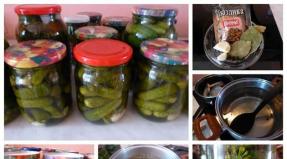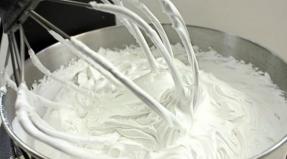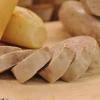Vedarai - baked potato sausages. Guts - recipes Beef guts recipe fried with onions
Peel and wash the potatoes and onion.
Pork intestines are divided into small and large intestines.
In the recipe, I indicated that 1 piece is needed - this is about 1.5-2 meters of the small intestine. Thicker parts will go away and shorter. In principle, both are suitable for preparing this recipe, but I prefer the thinner ones more.
Nowadays, it is already possible to buy prepared (already cleaned) intestines in many supermarkets of the city without any problems. They are sold in our salted and frozen form. Therefore, in order to prepare them for baking, you need to - first, just soak them in cold water. And when the intestines soften, then also rinse with running water. At this stage, the intestine is also tested for its integrity. If there are holes (this, alas, sometimes happens), then in this place the intestine must be cut off. There is nothing wrong here, we will just fill it with separate sausages.
Then mix with crushed garlic and leave so little for pickling - this is both for a pleasant aroma (especially if large intestines are used), and it is not bad for additional disinfection.

Then we need a special nozzle for stuffing sausages. No such? And okay ... Feel free to take a plastic bottle, cut the neck to get a kind of funnel, that's all the wisdom.
It remains only to pull the intestine "accordion" on the neck of the nozzle, and tie the free end in a knot so that when the intestine is filled, the filling does not "run away".

Pork lard can also be taken with a meat layer - a barrel - for example, we like this more than solid fat.
Cut the peeled onion, lard and bacon into small pieces (cubes).

In a preheated skillet, fry the pork barrel until it lets out the fat. Then add the chopped onion and fry everything on low heat until softened and light golden brown.
At the end, put in the chopped cubes of smoked bacon and fry for a short while. Set this roast aside - let it cool down a little.

It's time to grate the potatoes.
If you are the lucky owner of a special machine - a potato machine - the problem is solved, just grind the potatoes with it. Well, if there is none, then it doesn't matter. Just chop the potatoes on a fine grater. Just take care of your fingers, I know from myself - it can be painful through carelessness!
In the resulting potato mass, put about a third of the finished frying, dry marjoram, salt and pepper to taste. All that remains is to mix everything evenly.

Well ... Now we take the prepared intestine with a nozzle and begin to fill it with potato mass. Just spoon it into the tip and push the mass inward. The already filled intestine will begin to slide off the tip of its own accord and make room for the next portion.
So to fill the whole intestine with potato mass, the only and very important condition is not tight! Otherwise, the guts will burst during baking. Tie the end of the intestine.
If it so happened that the intestine turned out to be "full of holes" and the minced meat crawls out - just in this place you can cut it off and tie it up. You just get not one big sausage, but ready-made portioned sausages.

Put prepared "sausages" on a baking sheet greased with vegetable oil. Bake in an oven heated to 180 degrees for about 45-60 minutes. The time depends on the thickness of the sausages.
After 10-15 minutes, be sure to prick the entire surface of the sausages with a toothpick or thick needle. This is so that the steam generated inside does not "rupture" the intestine, but simply has an outlet for evaporation.
During baking, you must periodically open the oven and pour the fat on the surface of the sausages.

These sausages are served hot, as they say, "in the heat of the heat" with the remaining warmed frying and sour cream.
Bon appetit to you and your loved ones!

Trebuha is not included in the list of popular food products. Many have never tasted this offal and always pass by it on the market. But those who have tasted a tripe dish at least once know that it is possible to create a real delicacy from it. You shouldn't try to make a masterpiece out of a product if you don't know how to prepare it. For a start, it's still better to ask how much lamb or beef tripe should be cooked to make it tasty. But first you need to learn how to choose it.
How to choose a quality offal
From sellers you can hear another name for this product - scar. Basically, it is the front wall of the stomach of a ram or cow. The tripe is sold usually processed and ready for cooking. But you can also find unrefined offal. If you have never encountered the need to clean the entrails, then it is better not to get involved in this event. It will take a long time, and the procedure will seem a little pleasant and may discourage all the desire to cook a treat.
To choose really high-quality beef tripe, you should focus on its appearance and smell:

- Fresh product is light, has a grayish tint. The surface of a high-quality scar is shiny, covered with leathery villi. Sometimes you can find on sale the lower part of the stomach, on which there are no such villi. But it should also shine and have a diamond pattern.
- A quality offal smells like raw fresh meat. Extraneous, especially unpleasant, odors indicate that you have a very stale product in front of you.
- The presence of mucus or rotted parts indicates that the product is spoiled.
When choosing tripe for the first time, it is better to contact a specialized store. In the market, an inexperienced buyer can slip a low-quality product.
How to prepare beef tripe for cooking
If it turned out that you bought unpeeled tripe, preparation for subsequent cooking will take a lot of time. The first step is to turn it inside out. With a sharp knife, the mucous membrane is removed, which is a film lining the inner side of the stomach. You also need to get rid of fat, which can spoil the taste of the dish. The cleaned offal should be thoroughly rinsed in a significant amount of water, preferably under running water.
The next step is soaking. This procedure is necessary in order to eliminate the specific smell of tripe. To do this, use a weak solution of vinegar, or water with the addition of several crystals of potassium permanganate. Soak the scar for at least three hours. Now you need to get it out of the solution and rub it well with salt. After half an hour, you can rinse it and set it to cook.
How much to cook beef tripe
 You can cook many healthy and delicious dishes from beef tripe. In the traditions of different nations, it is used for first courses, served as a second course with a side dish, and various snacks are made. But first it needs to be cooked for more than one hour.
You can cook many healthy and delicious dishes from beef tripe. In the traditions of different nations, it is used for first courses, served as a second course with a side dish, and various snacks are made. But first it needs to be cooked for more than one hour.
The trebuha should be cut into convenient pieces or strips, covered with cold water and placed on the stove with a strong flame. Immediately after boiling, the first water must be drained and poured fresh. As it boils again, the fire is reduced. It takes 3.5 - 4 hours to cook all this beauty. The readiness of the product is determined with a knife. If the product is not completely finished, it will look like rubber.
While the tripe is being cooked, you need to salt it, add a bay leaf, a few peppercorns and a head of peeled onion to the water. This is usually done about 30 minutes before the end of cooking.
When the tripe is cooked, it is pulled out of the broth. Further, if desired: you can fry with onions and tomatoes, serve boiled with a lot of crushed garlic and broth, stew with vegetables. You can take ready-made recipes as a basis, or turn on imagination.
No matter how much entrails are in the pan, there should be twice as much water, since it is cooked for a long time and the water boils away strongly.
You can also cook a tripe in a multicooker. To do this, put the prepared offal in a bowl, salt immediately, add pepper, lavrushka and pour boiling water. Trebuha in a multicooker will cook in 4 - 5 hours. For dressing the finished dish, you can prepare frying of onions, carrots, aromatic herbs and tomato paste.
Trebuha perfectly lowers blood sugar levels, therefore it is indicated for use by people with problems such as diabetes mellitus and diseases of the gastrointestinal tract. She is also suitable for those who want to lose a few extra pounds. The energy value of the offal is 97 kcal per 100 grams of product. It is proven that regular consumption of tripe improves skin condition. However, it is not recommended to cook it more than once every 7 to 10 days.
Homemade sausage is a favorite dish in almost every home. This is a great option for breakfast, a hearty second course for lunch, a delicious snack during a break from work. Homemade chicken and rabbit sausages are suitable for baby food and for those on a diet. Hearty homemade sausage with fat will allow you to quickly feed a hungry man, smoked sausages will be a good snack, and raw smoked or ruddy fried sausages will decorate the festive table.
When buying ready-made sausages and sausages in a store, people usually do not even realize that they can make them on their own at home, and without having special equipment and special skills. The main thing is the desire and a little time to study the intricacies of the technical process. One has only to try once to make sausages or sausages in accordance with your tastes, and the desire to "sausage" in the kitchen will arise regularly. After all, what could be tastier than the freshest homemade sausage?

Having mastered the intricacies of technology and having tested your strength on basic recipes, you can subsequently fantasize about the sausage theme as much as you like. But first you need to master the process technology, think over and prepare the necessary equipment, materials, tools and ingredients.
The choice of raw materials, features of the technological process for the preparation of homemade sausages.
Only the best and freshest meat and meat products are used to prepare homemade sausages. It is especially important to consider this if homemade sausage is intended for long-term storage. In addition to pork, beef and veal, lamb, horse meat, venison, poultry and wild poultry and others are used. The meat can be either fresh or frozen. However, for long-term storage sausages, frozen meat is not worth taking. Also in this case, it is better to avoid ingredients such as lard, lungs, heart, liver, intestines, pork skin, pork head, cheek, fresh blood.
They take meat only from healthy animals, and not too young, since young meat does not have sufficient density and rich taste and the sausages will turn out to be slightly watery. If only the meat of young animals is available, it must be well dried before use or, in pieces and sprinkled with a third of the total amount of salt, kept in a cold place for 22–26 hours.
The lard for cooking sausages should be firm, but not frozen. The cervical or dorsal part, which is preliminarily kept for 2-3 days in a cool room, is best suited. Sausage casings are best taken immediately after slaughter, but you can buy fresh ones on the market or purchase specially processed, calibrated and packaged casings in the store. If desired, in specialized outlets or on the Internet, you can buy collagen casing, as well as twine, nets, ham dishes and everything you need for the production of sausages.
For housewives who value time and do not want to risk the health of loved ones by purchasing a product on the market, the quality of which is difficult to check without proper experience in this matter, buying a ready-made worm or collagen casing of the required diameter is an excellent way out of the situation. If you plan to buy sausage casings on the market, then you need to immediately decide what kind of product you will cook, and accordingly select the raw materials.
Beef intestines are used to make almost all types of homemade sausages, but they are especially good for those that are intended for long-term storage, since they are thicker and stronger than pork. Pork intestines are commonly used to prepare homemade sausages with various fillings. From beef and pork, from pork alone, from chicken, from rabbit, nutria, and also for sausages with fillings, liver, blood, porridge, etc. Lamb intestines are best suited for making thin sausages or hunting-type sausages. Of course, the intestines should be intact, thoroughly washed and cleaned.
Selection of meat for making homemade sausages.
Choosing meat for homemade sausage requires some knowledge. As already mentioned, young meat is less suitable due to the high liquid content. Older, denser and even slightly tough meat will give a richer taste and lower shrinkage, that is, it does not “shrink” so much during heat treatment.
All meat from the back half of the beef carcass, with the exception of the drumsticks, is the best premium meat for making sausages. Front meat is less valued, used for lower grade sausages or mixed with other meats. Frozen meat, before rolling it, must first be gradually thawed, but not brought to full softening.
Pork for sausages is chosen differently. The fillet, cut from the back, goes to the sirloin sausage. The meat cut from the neck is also salted in whole pieces and used to make ham sausages. The meat removed from the shoulder blades, brisket and sides is used to make first-class sausage, and the intercostal meat and barrels go into the lower-grade sausage. If the animal is of a meat breed or is not fat enough, then all parts of the carcass go to the preparation of sausage meat.
When the meat for the sausage is divided into pieces, it is advisable to sort it out and trim it. With the help of a sharp one, remove veins, tendons, membranes, large vessels, as well as those parts that reduce the quality of the sausage and during cooking which form jelly or glue). The more thoroughly the meat is cleaned from these parts, the more tender, tasty and nutritious the homemade sausage made from it will be.
When cutting very fatty carcasses, it is advisable to separate the meat from the fat that has grown into the muscles as carefully as possible, but - pay attention - this remark does not apply to pork. When processing it, only fat and coarse tendons are removed. Fatty lard removed from the carcass of a pig is also divided according to quality. The dorsal fat is considered the best, and the fat removed from the chest, belly and sides is inferior to it in quality.
Homemade hot smoked sausage, a few simple recipes.
Recipe for making homemade semi-smoked sausages.
3 kg of beef, 4 kg of semi-fat pork, 3 kg of fatty pork belly, 300 g of salt, 10 g of ascorbic acid, 1/2 tsp. ground black pepper, 1/2 tsp. ground allspice, 1 tsp. sugar, 1-2 cloves of garlic, starch. Cut the meat into pieces, put in a container, sprinkle with a mixture of salt and ascorbic acid, and stand for 3 days. Grind the salted meat. Pass the beef through a meat grinder once. Either pass the semi-fat pork through a large grinder or cut into small pieces (1–1.5 cm). Cut the brisket into 2 times larger pieces. After that, mix the chopped beef thoroughly by adding ground pepper, sugar and chopped garlic.
Add chopped pork to the cooked mass and mix the minced meat again until a homogeneous viscous mass is obtained. Add chopped brisket and mix the minced meat thoroughly again. At the very end, add starch - 180 g per 10 kg of meat. Fill the prepared minced meat into the guts and tie them with twine. Hang the tied rings or loaves of sausage in a cool place for 4–5 hours.
Smoke the dried sausage at a temperature of 60-90 degrees for 40 minutes. Then immerse it in boiling water, lower the water temperature to 70-80 degrees and cook the sausage for about 1 hour. Hang it up again in a cool place to cool for 3-4 hours. Smoke the cooled sausage at a temperature of 35–45 degrees for 12–24 hours. At the end of smoking, the finished homemade sausage is dried for 2–4 days.
Recipe for making smoked boiled spicy homemade sausage.
2 kg of beef, 500 g of lean pork ham, 1 kg of pork fat, 150 ml of vodka, 2 g of chopped cloves, salt, ground red pepper, 1 tbsp. l. lemon zest. Chop beef and lean pork ham into small pieces. Chop pork fat. Mix everything, add chopped cloves, ground red pepper, grated lemon zest and vodka. Fill the intestinal membranes with the mixture and tie with twine or threads. Put the sausage in cold water, bring to a boil and cook for 50 minutes. Then take out and wipe well. Prepared homemade sausage 24 hours.
The recipe for making boiled smoked homemade sausage.
7 kg of fatty pork, 800-1000 g of lean pork, 1.5 kg of beef, 1 liter of water, 80 g of salt, 4 g of saltpeter, 1 tsp. sugar, ground black pepper, garlic to taste. Cut the pork into strips 4–5 cm long and pour over a brine made from water, salt, saltpeter and sugar. Soak the meat in brine for a day. Separate the beef from fat and tendons, mince twice with a fine grid. Pass the pork through a meat grinder with a larger grill, combine with beef.
The mass should be soft and elastic. Add enough water to the resulting minced meat to make a viscous mass, mix thoroughly, add spices. Stuff the casings, tie with twine and smoke for 1.5-2 hours at a temperature of 100-120 degrees. After that, homemade sausage is boiled in water over medium heat for an hour.
The recipe for making homemade pork sausages.
1.5 kg of lean pork, 400 g of fatty pork belly, 200-300 g of lean beef, 20 g of curing mixture, 2 tbsp. l. pink pepper, 1 tsp. ground nutmeg, 1 tsp. ground ginger, 1-2 tsp. marjoram. Pass the meat through a meat grinder, add salt, spices and mix thoroughly so that the mass becomes homogeneous and moderately viscous. Fill the prepared pork belly with minced meat. In the process of filling, twist the intestine in several places, dividing it into separate sausages 25-30 cm long. Smoke with smoke heated to 80-90 degrees for 1 hour, then the homemade sausage is cooked for 30 minutes at 65-70 degrees.
Recipe for making homemade pork sausage with tongue.
500 g of lean pork, 500 g of pork belly with layers of fat, 500 g of veal, 500 g of boiled bacon, boiled pork tongue (about 500 g), 25 g of salt, 20 g of curing mixture, 1/2 tsp. ground white pepper, 1 tsp. ground nutmeg, 1 tsp. cardamom, 1 tsp coriander, allspice to taste. Pass pork, pork brisket and veal through a meat grinder with a fine wire rack.
Cut the pre-peeled tongue and boiled bacon into cubes with sides of 1 cm, combine with the cooked minced meat. Knead the filling so that the bacon and tongue are evenly distributed. Add salt and spices, mix thoroughly again. Fill the pork belly with minced meat and tie tightly. Form small loaves. First, boil the sausage for 1 hour in water at a temperature of 70 degrees, and then the homemade sausage is smoked at 80–90 degrees for 60–70 minutes.
Recipe for making brain homemade sausage.
1.3 kg of pork belly with layers of fat, 300-400 g of lean pork, 400-500 g of pork brains, 50 g of curing mixture, 100-120 g of onions, 1 tbsp. l. ground white pepper, 2 tsp. ground allspice, 1 tsp. ground nutmeg. Pass all types of meat and peeled brains through a meat grinder with a fine grid. Add salt, finely chopped onion, spices and mix thoroughly to make the mass homogeneous. Fill the prepared casing with minced meat and, twisting it in several places, divide into sausages 15–20 cm long. First, smoke them with warm smoke (smoke temperature is about 70 degrees) for at least 1 hour. Then homemade sausage is boiled in water at 80–85 degrees for 30–40 minutes.
Homemade horse sausage recipe.
10 kg of fatty horse meat, 160 g of starch, 2 tsp. granulated sugar, 1 tsp. ground black or red pepper, 1 tsp. ground allspice or 1 tsp. ground coriander, 3-4 cloves of garlic. Cut the fattest parts of the meat into small cubes. Pass the rest of the meat through a meat grinder. Mix the minced meat, chopped meat and spices, add salt, knead everything so that the mass is homogeneous. Fill shells with minced meat, form small loaves, hang to dry for 3-4 hours. Then smoke the sausages at a temperature of 70-85 degrees, let cool for 2 hours. Boil smoked sausage at 70-80 degrees until tender.
Guts are a product used in almost every kitchen to prepare all kinds of dishes. On average, their calorie content per 100 grams is 602 kcal. Protein content - 8 g, fat - 63 g, carbohydrates - 0 g.
Pork and beef intestines are most commonly used, although some peoples may also use lamb, horse and goose intestines. This ingredient is good not only for its excellent shape-keeping property, but also for the presence of beneficial digestive enzymes that improve the absorption of nutrients by the body.
How to prepare for use
Fresh, uncleaned intestines usually have an unpleasant odor, but with proper handling it can be eliminated. To do this, you need to perform several actions:
- Turn the intestines inside out and rinse them with running water.
- Pour with saline solution with the calculation of 3 tbsp. salt in 0.5 liters of water and wait 5-6 hours.
- With the blunt side of a knife, carefully and slowly clean the product from fat.
- Rinse again with water and leave in saline solution for 3-4 hours. Repeat the entire algorithm three times, and then turn out the intestines again.
The cleaned intestines can be stored in the freezer for about a year. To do this, they need to be given the opportunity to drain, and then - fill them with salt.
What to cook
Natural intestines are the best casing for all kinds of homemade sausages - fried, smoked, semi-smoked, baked, stewed, steamed. With their help, you can cook:
- garlic mini pork sausages;
- bloody;
- chicken sausages with cheese;
- kupat;
- liverwort and potato sausage;
- hunting sausages and much more.
Also, the intestines can be used not only as a shell. They can become an ingredient in the filling of all kinds of dishes (for example, the Azerbaijani dish garyn gutaby).
Using step-by-step recipes with photos, everyone can cook delicious and original dishes from this product.
Of all the meat snacks for beer, homemade sausages are, perhaps, one of the most interesting and not "overused" among connoisseurs of beer parties. Steaks, kebabs, burgers and other culinary pranks cannot compete with a dish whose history goes back several centuries. Don't believe me? Ask any German who has smoked his next Oktoberfest from dawn to dusk.
Grilled or pan-fried meat sausages are one of the most delicious beer snacks, as evidenced by the menu of the world's largest "beer" festival - Oktoberfest. This time we will understand the general intricacies of cooking sausages at home, and also consider the simplest and fastest recipe for homemade sausages in the intestine in a meat grinder.
Of course, each chef has his own recipes, subtleties and tricks: someone loves chopped meat, someone from well-ground meat, someone puts in a lot of spices, while others get by with salt and black pepper. Therefore, to begin with, we will just look at the general principles that will help you prepare juicy, satisfying and tasty sausages at home.
Meat selection
Almost any meat is suitable for homemade sausages: chicken, pork, beef, lamb, duck, turkey, etc. Can be used as one type of meat, or mix several types in different proportions, depending on taste preferences. So, fatty pork is often mixed with beef, and poultry is most often used in pure form or with the addition of lard for greater juiciness.
When choosing pork, you need to pay attention to lard: if it is tasty, aromatic and with a thin skin, then the meat from this animal will also be of good quality. When choosing lamb, you need to look at the veins: if they are soft, then the meat will also be quite tender.
If dry meat was chosen for the sausages, with a minimum of fat, then you can add cream or ground lard to make them more juicy.
Cooling
Before starting cooking, it is advisable to cool the meat cut into small pieces and the meat grinder in the freezer, which will provide a better grind, and will also help to preserve the taste of the meat. The meat grinder can be placed in the freezer an hour before the start of cooking, or in advance, at night. The meat should not be frozen: it should freeze on the edge, and the center will remain soft.
Grinding
As soon as you pulled out everything you need from the freezer, you should start right there, and you need to grind it as quickly as possible, while loading the meat in small portions. During grinding, you do not need to force the pieces into the neck, as this can disrupt the consistency of the future minced meat. The ideal degree of filling is ¼ of the volume of the neck.
Kneading
After grinding, you should get minced meat with a visible texture. Spices and other additives are added to the finished mass, if they are provided for by the recipe, after which the minced meat must be kneaded with your hands so that it becomes denser and excess air leaves it. You can check the taste of the minced meat obtained by frying a small amount in a pan. Fry until tender, but do not wait for a golden brown crust, as it will slightly "obscure" the main taste of the product. After the "test", you can add the missing ingredients to the minced meat and knead it again.
Shell
Today it will not be difficult to buy a casing for homemade sausages in a store, it can be natural or artificial. Natural - these are specially processed pork, beef or lamb intestines. They can vary in diameter, length, and section of the intestine of the animal. When choosing intestines, you should pay attention to their characteristics: there should be no nodules, large holes, greasy smell, the color should be light, without gray shades. Beef casings are stronger than pork casings, so they can be easier to work with if you're making sausages for the first time. But lamb is more suitable for boiled sausages and ham. However, the choice is yours.
Before use, the intestines need to be rinsed with warm water and soaked in 20-25 ° C water for an average of up to 2 hours (freshly preserved ones can be soaked for only 5-10 minutes). Then they are washed in water (30-35 about C). Next, the intestines are disassembled into pieces and their quality is checked by passing water through them. If there are holes in the womb, then it is in these places that the intestine should be cut into separate parts.
Artificial casings are also of various types, including cellulose, polyamide, protein. Collagen casings, which are made from protein raw materials and are edible, are well suited for homemade sausages. To prepare the collagen "gut" should be soaked in water (with the addition of 1 teaspoon of salt per 1 liter of water) 35-40 o C for 2-3 minutes, then rinsed with running water.
Casing filling, sausage shaping
When the minced meat and casing are prepared, you can begin the process of forming homemade sausages. A simple way is to change the nozzle on the meat grinder to a special cone, put the intestine on it. You need to tie a knot only after you start serving minced meat, otherwise an air bubble will form. As for the density, the golden mean should be maintained: a highly densely stuffed sausage can burst at high temperatures, and if the density is insufficient, voids will form. You can find the optimal degree of density empirically 😉
Tip: If you doubt the tightness of the filling or you could not avoid the appearance of air bubbles, then it is better to prick the sausages with a thin needle or toothpick so that steam comes out during cooking.
The second option is in case you do not have such a special attachment or even a meat grinder. A cropped top from a plastic bottle will help. It can be fixed in a meat grinder or used as a hand tool by pushing the minced meat through the neck while adjusting the packing density.
Tip: If you want to make one large sausage, then you can immediately lay it in a spiral, if small, then you should leave a sufficient gap between the minced meat portions so that it is convenient to tie or twist the intestine. You can tie it with cotton twine.
Heat treatment
At home, sausages can be fried, boiled and baked, and you can also combine these processing methods. With any method, a certain temperature regime should be observed: in order to keep them juicy, they should be cooked at a temperature of no more than 80 ° C.
In a frying pan, fry over medium heat, first on one side, then, slightly increasing the heat, on the other side. The readiness indicator is the clear juice released when the sausage is punctured. While frying, you can try putting a sprig of rosemary in the pan and periodically pulling it out of the fat and running it over the sausages (this will give the dish a subtle rosemary flavor).
In the oven, you can cook sausages both on an open baking sheet and in foil. In the first case, you should periodically water them with fat or oil so that they are not dry, in the second, unfold the foil towards the end of cooking, so that a golden brown crust appears.
Tip: Instead of vegetable oil for frying and baking sausages, you can use beef fat, it will make the dish more juicy and tasty.
You can boil sausages in different ways, for example, put them in slowly boiling water, turn off the heat and leave them covered for 20 minutes. Cooking is often used before stewing or frying in a pan.
Spices and additives
Recipe for making homemade sausages without guts
If you don't have a natural or artificial casing at hand, you can cook homemade sausages in cling film, foil, parchment, etc. For example, let's take a recipe with minced meat from a mixture of chicken and pork with the addition of eggs, baked in foil. You can use other combinations of meat and their proportions, as well as add spices and other ingredients of your choice.
Ingredients:
- Pork (tenderloin) - 1 kg
- Chicken fillet - 0.7 kg
- Pork fat - 0.2 kg
- Eggs - 3-4 pieces
- Starch - 4 tbsp. spoons
- Garlic - a few cloves
- Salt, pepper, spices
Preparation:
1. Beat eggs in a bowl, add spices, chopped garlic (pass it through a garlic press or finely chop it), salt. Then we begin to gradually add starch, stirring constantly and preventing the formation of lumps.
2. Make minced chicken, pork and bacon. If you want a finer grind, use a fine-perforated nozzle. You can also make "chopped" sausages, for which the meat and lard just need to be cut into very small cubes. Put the minced meat or chopped ingredients in a bowl with eggs, mix well until a homogeneous mass is formed.
3. Take the foil, cut into equal pieces of about 20x30 cm. Put the minced meat with a spoon on the shiny, mirror side of the foil and form the sausages of the desired shape and size, after which we begin to wrap like candy. Twist the edges tightly so that there is no air gap between the minced meat and the foil. It is advisable to twist more tightly than shown in the photo.
4. Preheat the oven to 180 ° C, send a baking sheet with sausages there and mark for 1 hour. Homemade sausages without intestines can be served hot and cold, with a side dish and simply flavored bread.




















